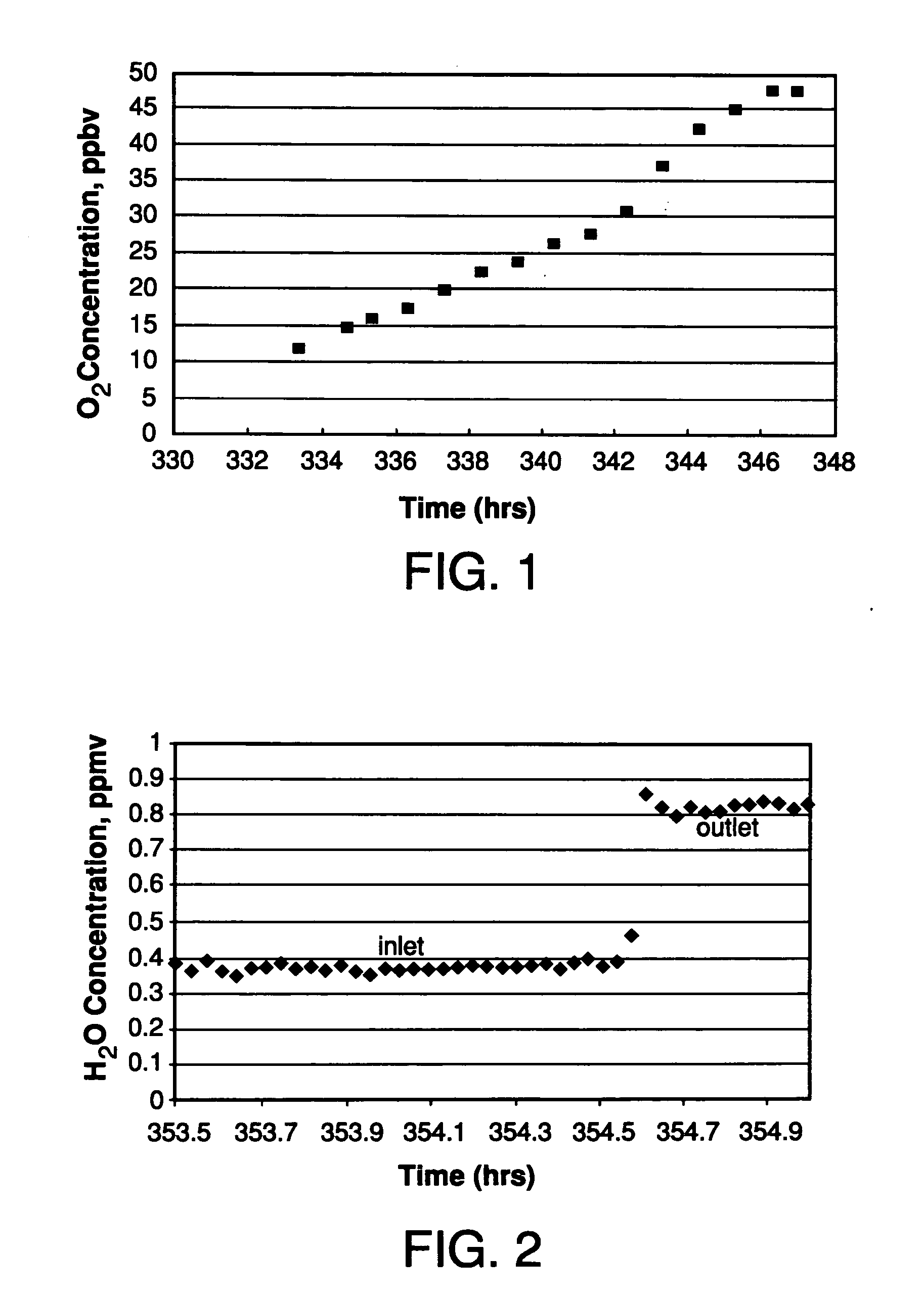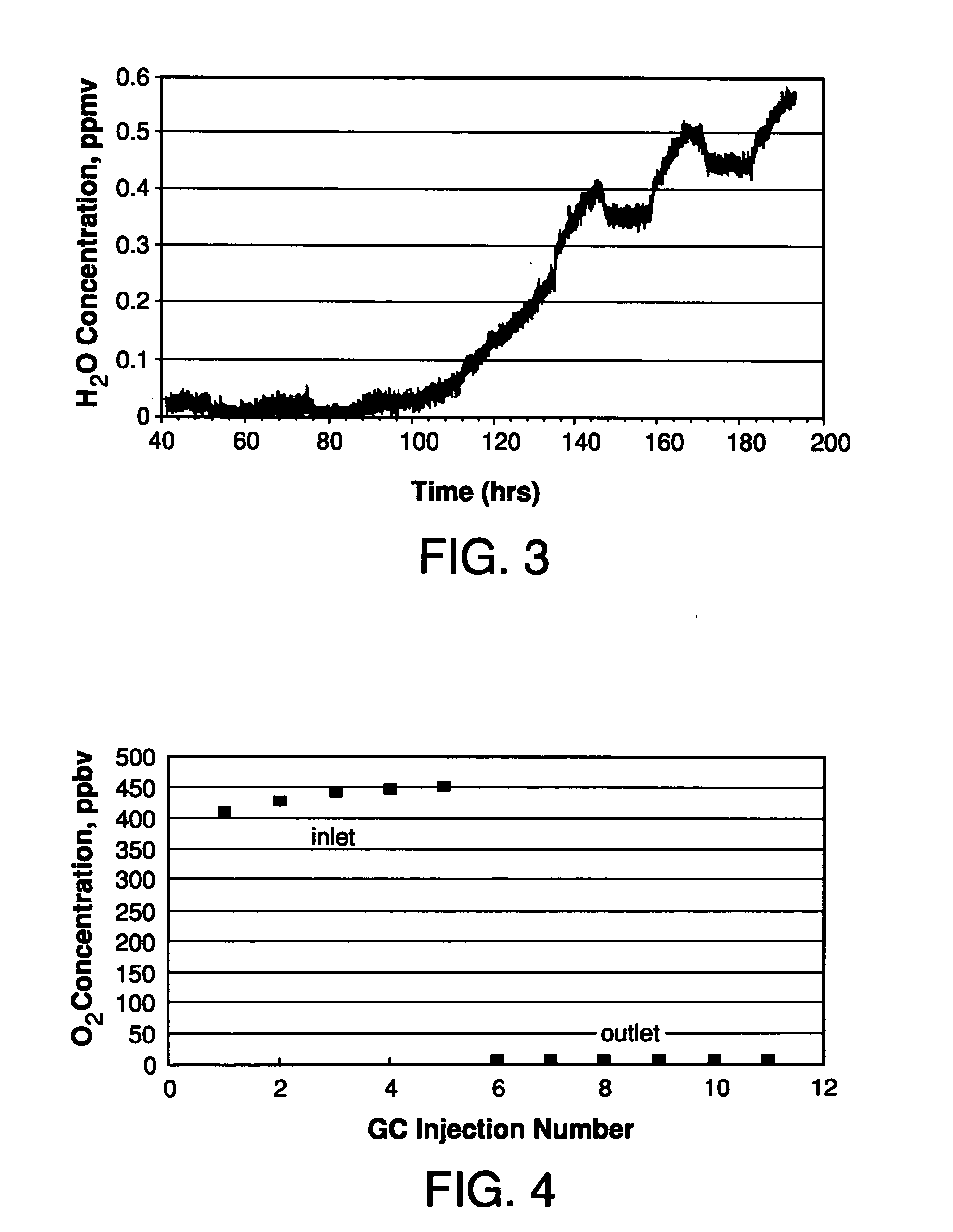Purification of hydride gases
a technology of hydride gas and purification method, which is applied in the direction of nitrogen purification/separation, other chemical processes, separation processes, etc., can solve the problem of difficult cost-effective removal of impurities to these ppb levels
- Summary
- Abstract
- Description
- Claims
- Application Information
AI Technical Summary
Benefits of technology
Problems solved by technology
Method used
Image
Examples
example 1
[0074] A supported metal oxide adsorbent was prepared by impregnating 40 grams of 6×12 mesh coconut shell carbon (Type PCB from Calgon) with 28 cc of 50 wt % Mn(NO3)2 solution. The sample was air dried at ambient temperature, then activated at 400° C. in N2 for 16 hours. The activation treatment decomposed the nitrate to the oxide and the reducing potential of the carbon resulted in a supported reduced MnO on carbon. The final loading of Mn on the carbon was 2.0 mmole / g.
[0075] Adsorption of O2 was conducted on this material in a standard volumetric adsorption apparatus at 30° C. At an O2 pressure of 0.0002 atm, the O2 uptake rate and equilibrium capacity were determined. The equilibrium capacity was 0.21 mmole O2 / gram of adsorbent. Based on the loading of Mn, this material adsorbed 0.105 moles O2 / mole of Mn. The spent adsorbent was regenerated at 400° C. in flowing nitrogen at 2 cc / g-min and oxygen adsorption was repeated as above. The regeneration / adsorption cycle was repeated two...
example 2
[0076] A commercially-available MnO-based catalyst, which is essentially an unsupported metal oxide material, was activated in 4 vol % H2 in N2 at 400° C. for 16 hours and the adsorption of O2 was conducted as described above. The O2 capacity measured at 0.0002 atm was 0.23 mmole / g. Since this material is pure MnO, the Mn loading on this material is 0.014 moles Mn / g of catalyst. Based on this Mn loading, the material adsorbed 0.016 moles O2 / mole of Mn. Clearly, the supported MnO adsorbent of Example 1 provides a higher O2 / Mn ratio than the unsupported oxide material. As shown in Table 2, the O2 capacity on a Mn loading basis of the supported MnO adsorbent is about 7.5 times higher than that of the unsupported MnO material. In addition, the activated carbon-supported material of Example 1 required only N2 for activation, while the unsupported MnO material requires reduction in H2 for activation.
TABLE 2Comparison of Supported and Unsupported MnO AdsorbentsOxygen Capacity @30° C., 0....
example 3
[0078] A supported MnO adsorbent material was produced by impregnating 50 grams of activated alumina (Alcan AA-300) with 18 cc of 50 wt % Mn(NO3)2 solution. The material was air dried at 70° C. and activated in 4%H2 in N2 at 400° C. for 16 hours. The resulting material had a Mn loading of 1.2 mmole / g. An O2 capacity of 0.078 mmole / g adsorbent was measured in a standard volumetric adsorption apparatus at 30° C., and this corresponded to a molar ratio of O2 to Mn of 0.065. While this value is lower than that measured on the carbon-based adsorbent, the alumina-based adsorbent still has a higher O2 / Mn ratio than bulk MnO (4.6 times higher), indicating the enhanced ability of finely dispersed, small particles MnO to adsorb O2. The alumina-based getter has the added advantage that is a good desiccant and therefore can simultaneously adsorb water and O2.
PUM
| Property | Measurement | Unit |
|---|---|---|
| Time | aaaaa | aaaaa |
| Time | aaaaa | aaaaa |
| Time | aaaaa | aaaaa |
Abstract
Description
Claims
Application Information
 Login to View More
Login to View More - R&D
- Intellectual Property
- Life Sciences
- Materials
- Tech Scout
- Unparalleled Data Quality
- Higher Quality Content
- 60% Fewer Hallucinations
Browse by: Latest US Patents, China's latest patents, Technical Efficacy Thesaurus, Application Domain, Technology Topic, Popular Technical Reports.
© 2025 PatSnap. All rights reserved.Legal|Privacy policy|Modern Slavery Act Transparency Statement|Sitemap|About US| Contact US: help@patsnap.com


